
I help gardeners grow
& beginners blossom.
No seed left behind,
no soil unturned.
Together we can have lots of fun growing
great gardens using simple practical tips.
- Featured in -





Start saving & storing your garden seeds for a more more sustainable future
SIGN UP to get the FREE Seed packet PDF
X CLOSE

Cooking Up My Garden: Leek and Potato Soup!
Cooking Up My Garden: Making Leek & Potato Soup
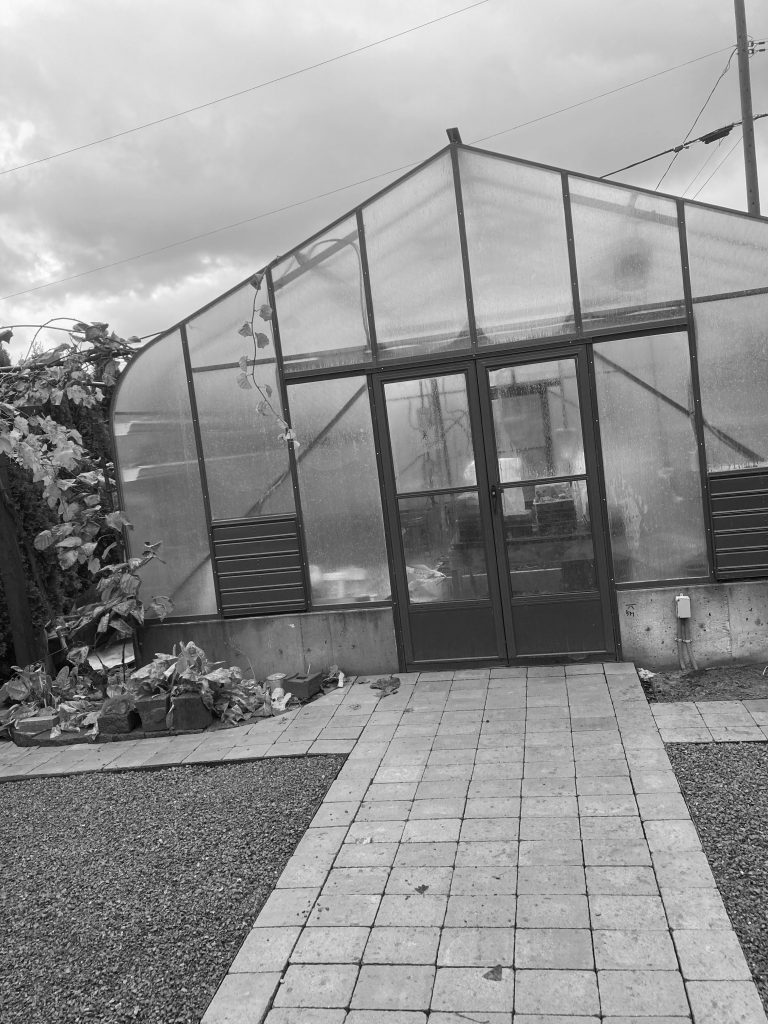
I realize I am spoilt and many of the items I use in my cooking come from my greenhouse and very mild climate garden. But by showing you what I grow and how I grow it, I hope readers will be able to copy relevant ideas and find a way to grow basic food for their climate and conditions. And don’t feel bad if you have to buy some of the ingredients. Remember the cinnamon buns? I buy ingredients from time to time too!
This morning I made cinnamon buns and not a single thing in them came from my garden. Quite simply they contained flour, sugar, yeast, milk, butter, eggs and cinnamon. Seven out of seven items used in this baked treat came from the store instead of my yard.
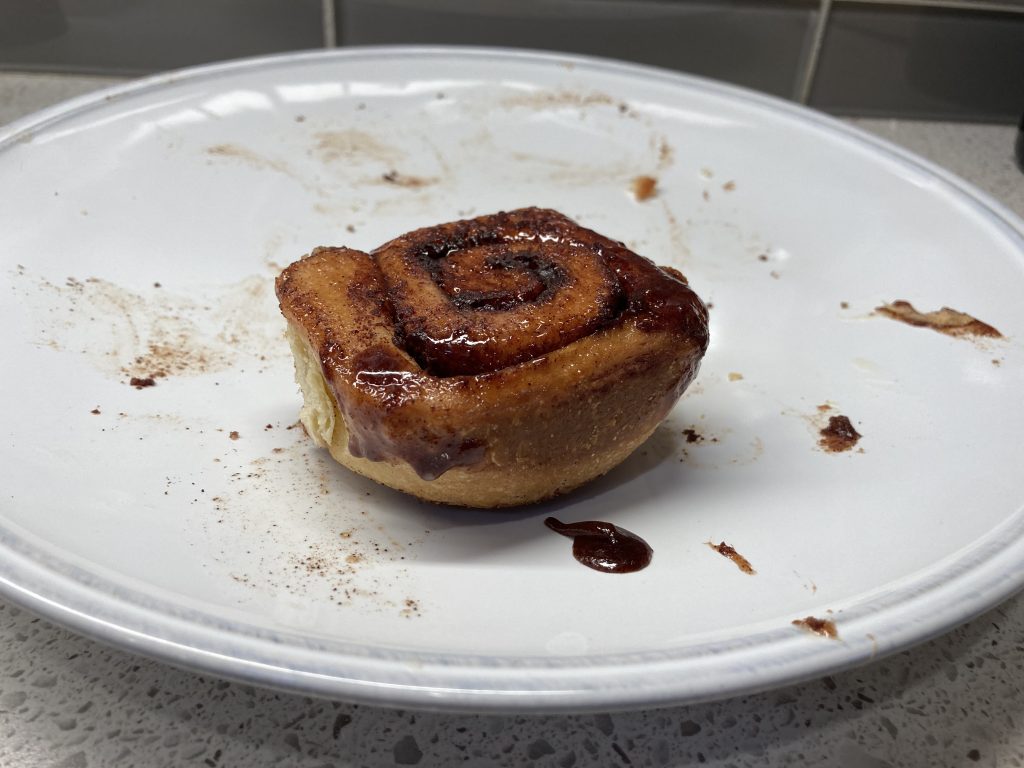 Too bad I forgot to take a photo when I pulled the full pan of cinnamon buns from the oven this morning. Oh well, you get the drift. They were lovely. While they lasted.
Too bad I forgot to take a photo when I pulled the full pan of cinnamon buns from the oven this morning. Oh well, you get the drift. They were lovely. While they lasted.
But the antidote to sweet and sticky cinnamon buns are the things I can and do grow in my garden. And today, our supper is 90% fresh picked from my back yard on November 22, 2020. Seriously. I know it seems incredible but back by popular demand in our family is the vegan-inspired Leek & Potato soup. I first made it a few weeks to rave reviews. (The base recipe comes from The Joy of Cooking, 1975 edition, but I have reinvented it and added a veggie broth of my own.)
 Leek and Potato soup fresh from the garden with 90% of the ingredients grown by me including 4 members of the onion family. The only things I bought were salt, pepper, Olive oil and almond milk to make this Vegan soup “creamy”.
Leek and Potato soup fresh from the garden with 90% of the ingredients grown by me including 4 members of the onion family. The only things I bought were salt, pepper, Olive oil and almond milk to make this Vegan soup “creamy”.
I like the idea of recording and taking photos of the vegetables in my kitchen and garden and, starting with this blog post, I hope to grow these blogs into a collection of recipes from my own yard. When you see a blog post starting with “cooking up my garden” you will know it is something inspired by my garden and prepared in my kitchen. The cook and gardener are one and the same in this case of course but you get my drift. It could be you and your garden just as easily.
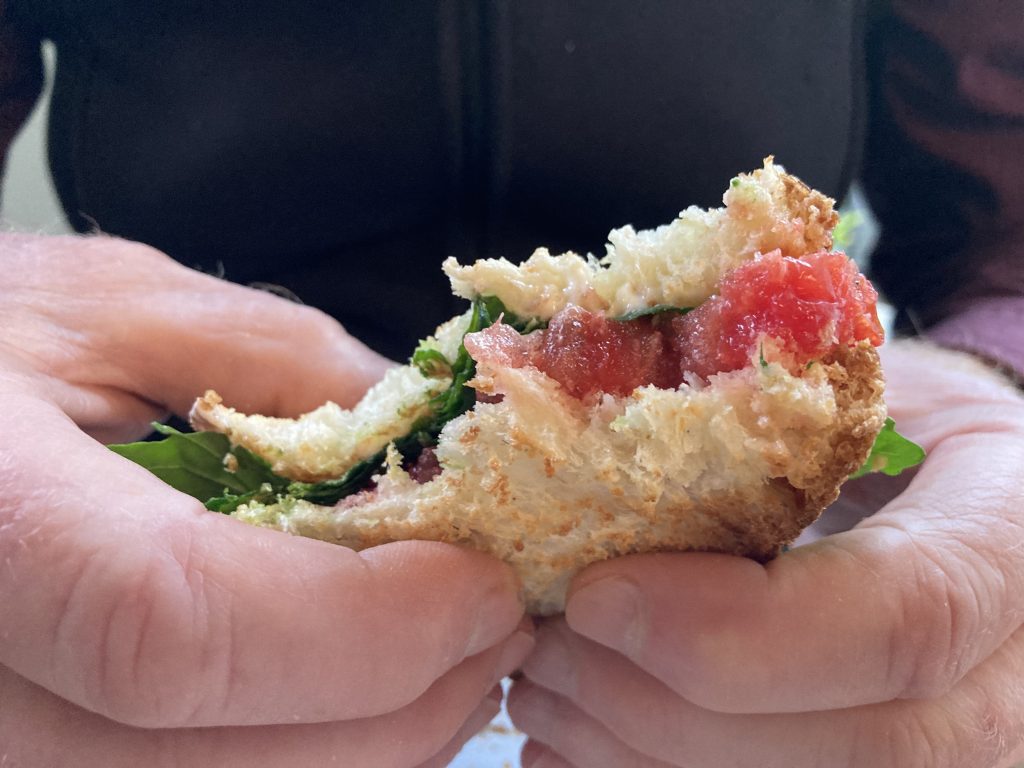 Cooking doesn’t have to be difficult. Even a simple toasted tomato sandwich is better when made with your own fresh tomatoes and arugula. Yummy.
Cooking doesn’t have to be difficult. Even a simple toasted tomato sandwich is better when made with your own fresh tomatoes and arugula. Yummy.
I love to cook but mostly I love to be inspired to cook by my garden and what is growing in it. I seriously don’t think I could go back to the old model of shopping for exotic foods from the store and combining it every night into a dinner. Except for cinnamon buns. I will always need cinnamon buns. And to get those I will need cinnamon from the tropics and flour from the nutrient-rich soil of the prairies.
 Yesterday I pulled a cabbage out of my garden, peeled off the bad bits and fried it up for lunch with leftover rice and kidney beans harvested from my garden. Yummy.
Yesterday I pulled a cabbage out of my garden, peeled off the bad bits and fried it up for lunch with leftover rice and kidney beans harvested from my garden. Yummy.
So if you like this new idea let me know. It won’t be anything fancy. Mostly I will cook with the vegetables and herbs I grow and either pick fresh or pull from my cupboard, freezer or dry inventory. I will explain simply how I grow the ingredients and offer the recipe so you too can cook from your garden.
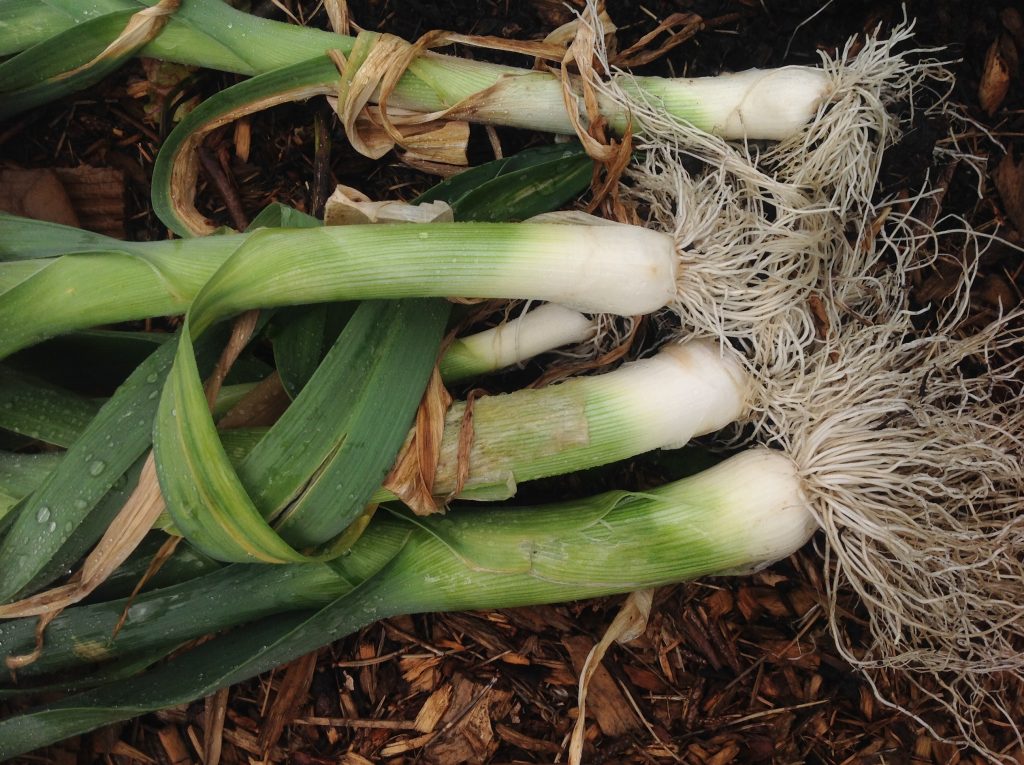 Leeks pulled from the garden have a distinct white part and a light green part before you get to the dark green leaves. I always use the white and light green part but never the dark green part. It is too coarse.
Leeks pulled from the garden have a distinct white part and a light green part before you get to the dark green leaves. I always use the white and light green part but never the dark green part. It is too coarse.
Items Grown in my garden for Potato-Leek Soup:
Bay leaf, celery, leeks, carrots, garlic, onions, chives, yellow onion, tomatoes and potatoes.
Ingredients for Veggie Broth (make this a day or even a week ahead of time):
The secret to any good soup is the broth. I fill a stock pot half full of water and then add items from my garden or fridge: 3 Carrots cut into rounds, 1 yellow onion coarsely chopped including skin for colour, 3 cloves of garlic crushed, 2 fresh or dry Bay leaves, a handful of cherry tomatoes (about 10) from the pantry (pick the wrinkled ones you won’t want to eat fresh this late in the season) and a stalk or two of fresh or dried celery.
If I come across anything else like a kale leaf or two I add those in as well. The more the merrier. But no beets. This is going to be a white soup and I don’t want it taking on a pink hue. It’s not valentines day yet.
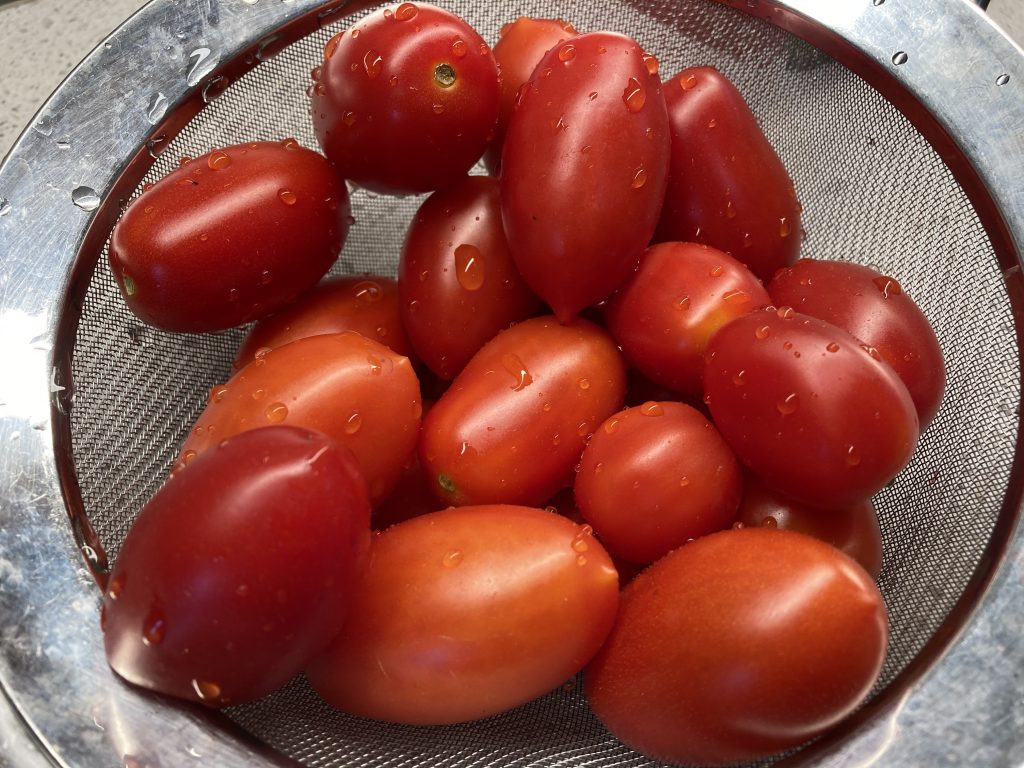 Juliet tomatoes are on my “to grow” list every year. This is because they are sweet (a Brix of 6) and they are paste-type so are easy to cook into sauce. I also find they are one of the earliest tomatoes I harvest and that is a good thing. Cutting a dozen or so in half and adding them to a stock will boost the flavour enormously.
Juliet tomatoes are on my “to grow” list every year. This is because they are sweet (a Brix of 6) and they are paste-type so are easy to cook into sauce. I also find they are one of the earliest tomatoes I harvest and that is a good thing. Cutting a dozen or so in half and adding them to a stock will boost the flavour enormously.
Method: Start the water heating and add the found ingredients listed above. If the only Bay leaf you have is dried that is okay. Add the tablespoon of salt right away. It will extract the flavours. Once boiling, turn the burner down low. Leave it on overnight or at least for several hours. (My son puts his stock pot on his wood burning stove overnight in the winter and others I know put their stock pot full of ingredients in the oven on dead low overnight. It all works.)
Once all the flavour is extracted into the stock and the vegetables are mushy and tasteless, they are tossed into your compost bucket. My husband thought we could use these vegetables again…. in the soup or in some other way but I said NO! They have given up all their flavour to the broth so the vegetables need to be composted so they can add their fibre to the soil.
(PS I made the mistake once of trying to save and re-use the vegetables I used in the stock and the result was mushy, tasteless vegetable soup. So do yourself a favour and once the broth is ready, strain it into a big bowl and set aside four-six cups of broth for the soup. Freeze any extras, and I repeat, compost the used vegetables.)
 Many books suggest using only the white part of leeks but after growing them for 8-9 months I use a lot more of the plant. I always use the white and most of the light green portions as well.
Many books suggest using only the white part of leeks but after growing them for 8-9 months I use a lot more of the plant. I always use the white and most of the light green portions as well.
Leek & Potato Soup:
Ingredients for stock – see above.
Ingredients for soup:
Large yellow onion or two small ones (about 1 cup when chopped fine)
3 large leeks, white and pale green part only
4 medium potatoes or 6-8 fingerling potatoes.
Chives for garnish
 These lovely random potatoes are pulled and washed for the Leek & Potato soup. I use about 4-8 potatoes depending on the size of each spud. These ones are smaller than you might expect because they are a late season potato and they keep making new young potatoes until the top growth dies.
These lovely random potatoes are pulled and washed for the Leek & Potato soup. I use about 4-8 potatoes depending on the size of each spud. These ones are smaller than you might expect because they are a late season potato and they keep making new young potatoes until the top growth dies.
Ingredients Bought For Leek & Potato Soup:
3 tablespoons Butter or Olive Oil or Avocado Oil
1-2 cups or 500 ml Almond Milk unsweetened and un-flavoured
Salt and pepper
Method:
Make stock, strain it and toss the old vegetables. Let stock sit until you need it (if it is going to be longer than an hour, keep it cooking in stock pot or strain it and put it in the fridge.)
Make soup:
Clean and slice leeks into 1 mm thick rounds and put them in a pot with butter or cooking oil on medium heat.
Peel, slice and dice onions and add them to the same pot as leeks. Brown well.
Wash and chop potatoes coarsely and mix them into the already started leeks and onions, stirring and mixing until soft. About 15 minutes.
Add 4-6 cups of reserved stock to the leek, onion and potato mixture. Stir to loosen any bits that have been sticking to bottom of the pot and put a lid on to finish cooking potatoes until they are soft.
Using a hand held blender grind everything up until fine.
Add 1 or more cups almond milk (or regular milk if you don’t have dairy sensitivities) and let pot warm up again but don’t let it boil.
Ladle into bowls, sprinkle chopped chives on top, add salt and pepper and serve with a crusty roll or toasted slice of nice bread.
 Leek and Potato soup is even better when chives are picked and sprinkled on top when soup is served. If you are all out of chives (because it is so darn cold where you live) try sprouting peas and adding the pea shoots (micro-greens) to the bowl as you serve.
Leek and Potato soup is even better when chives are picked and sprinkled on top when soup is served. If you are all out of chives (because it is so darn cold where you live) try sprouting peas and adding the pea shoots (micro-greens) to the bowl as you serve.
Yummy. Serves 4-6 and freezes well.
How to Grow Ingredients for Soup:
Bay Leaf- a tender tree so either grow in a mild climate as a broad-leaf evergreen or keep in a sunny window indoors in cold climates.
Carrots – Seed outdoors in mid to late spring – any time after mid-April. Cover rows of seed with a board and water well. Lift the board every few days to see if seed is sprouting and then lift and remove board. Cover whole arrangement with fabric fleece cover – like Agribon-19 to keep carrot rust flies away from roots.
Celery: seeded inside in March, transplanted into garden once outdoor temperature is mild – about mid-late May. Make sure they are in a moist area where the soft soil can be hilled around plants to keep them pale.
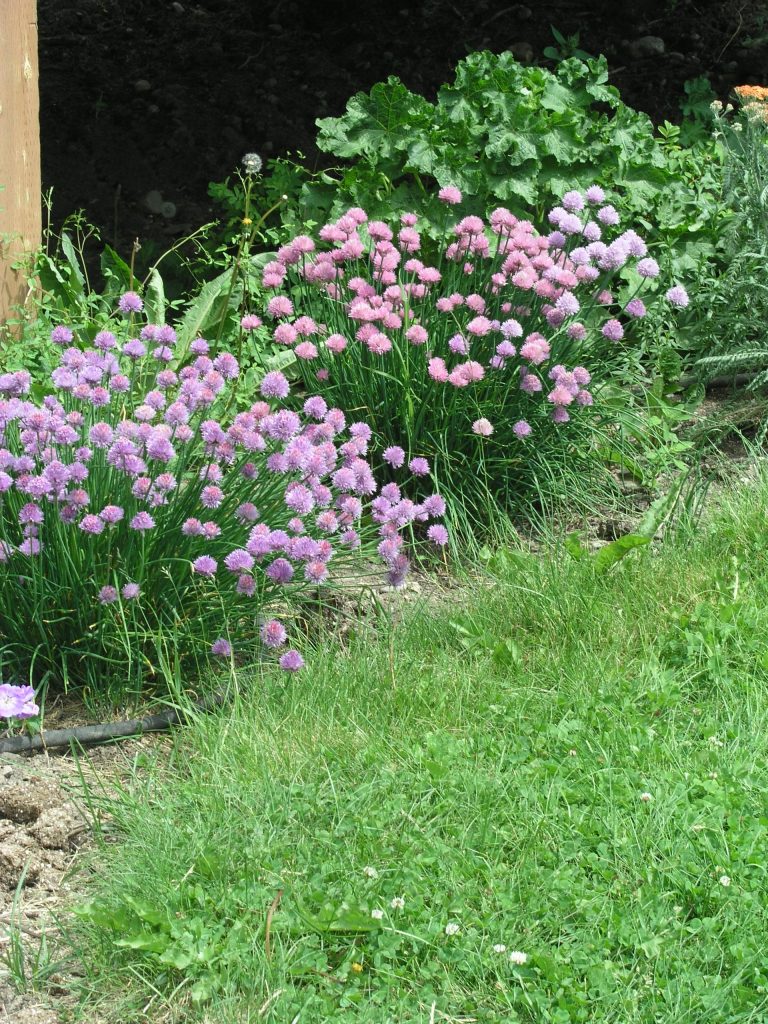 Chives are a favorite perennial herb in the garden and hardy too.
Chives are a favorite perennial herb in the garden and hardy too.
Chives – the only perennial onion hardy in all climates. Plant chives from seed or young starts in spring. Keep a few plants in the perennial borders so you always have access to the fresh herb as needed.
Garlic: plant individual cloves in fall once leaves start colouring and falling from trees. If you forget to plant in the fall you can sometimes get it at garden centres or organic stores in spring when it is sprouting. This spring-planted garlic won’t get as big as fall-planted cloves.
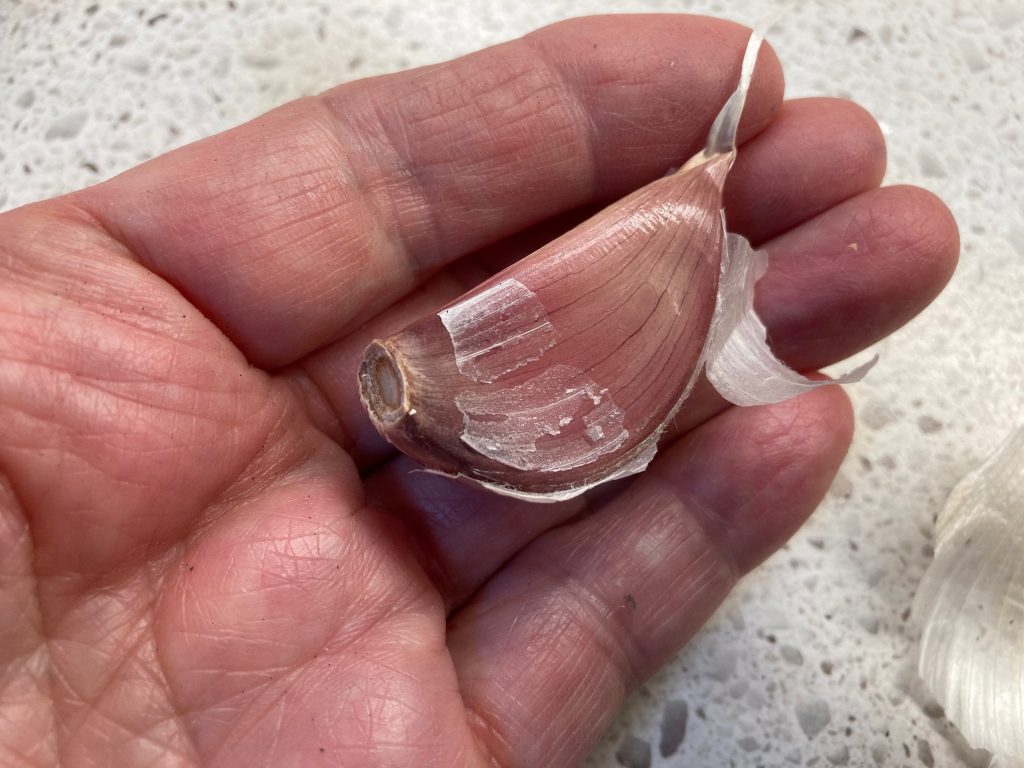 An individual clove is part of a head of garlic. This is one of four kinds of onions I use in my Leek and Potato soup but I only use a few cloves in the stock, not later in the soup.
An individual clove is part of a head of garlic. This is one of four kinds of onions I use in my Leek and Potato soup but I only use a few cloves in the stock, not later in the soup.
Leeks – start the seed in the house under grow lights in late January or early February. Transplant into individual cells or packs after growing for a month or more and then plant outside in early spring – from late March to mid-May. Harvest by pulling out the whole individual plant in November or whenever making the soup. On Vancouver Island I leave the leeks in the ground until late in the spring so this is a November to March soup. In colder climates pull them in late fall and store in fridge or root cellar.
Onions – Buy seed for northern latitudes (varieties are sometimes listed as long day ) and seed at the same time as leeks indoors (about 10 weeks before planting outside.) An alternate idea is to buy onion sets in spring. Make sure onions have moist soil and plenty of compost.
Potatoes – Early season potatoes like Warba can be planted early in pots in the greenhouse and then set outside in early June in cool climates. In milder climates start planting potatoes in the soil or pots as early as you can work the soil. Plant again every few weeks and grow late as well as early varieties so you have a continuous crop. When the plant blooms, reach around base of plant to pull a few early spuds. Once fall frosts or drought kill plants back, harvest the rest of the crop by yanking plants out of the ground and sifting for potatoes. Offer lots of water and fertilizer to keep plants and spuds growing.
Tomatoes- seeded in March, and transplanted once or twice to size up depending when spring comes to you. I move them into my greenhouse soil when it is 60 degrees F in late April. Outdoors, plant once danger of frost and spring rains are past in late May.
Once all the flavour is extracted into the stock and the vegetables are mushy and tasteless, they are tossed into your compost bucket. My husband thought we could use these again…. in the soup or in some other way but I said NO!
Cooking from the garden is as simple as looking around to see what is ready to harvest or already in storage. I will keep sharing cooking and growing recipes with readers over the next few blog posts. If you like them let me know.
PS I just got this photo from Cam, a client and my accountant. He is quite the baker and he made this pie and tarts from a little lemon he grew on his own tree planted this spring.
 Cam McClean isn’t just an accountant. He is a partner in his accounting firm, a musician in a band, and now I find out he is also a fine baker. Here is a pie he made this week from lemons he grew in his greenhouse this summer.
Cam McClean isn’t just an accountant. He is a partner in his accounting firm, a musician in a band, and now I find out he is also a fine baker. Here is a pie he made this week from lemons he grew in his greenhouse this summer.
And here is his tiny tree:
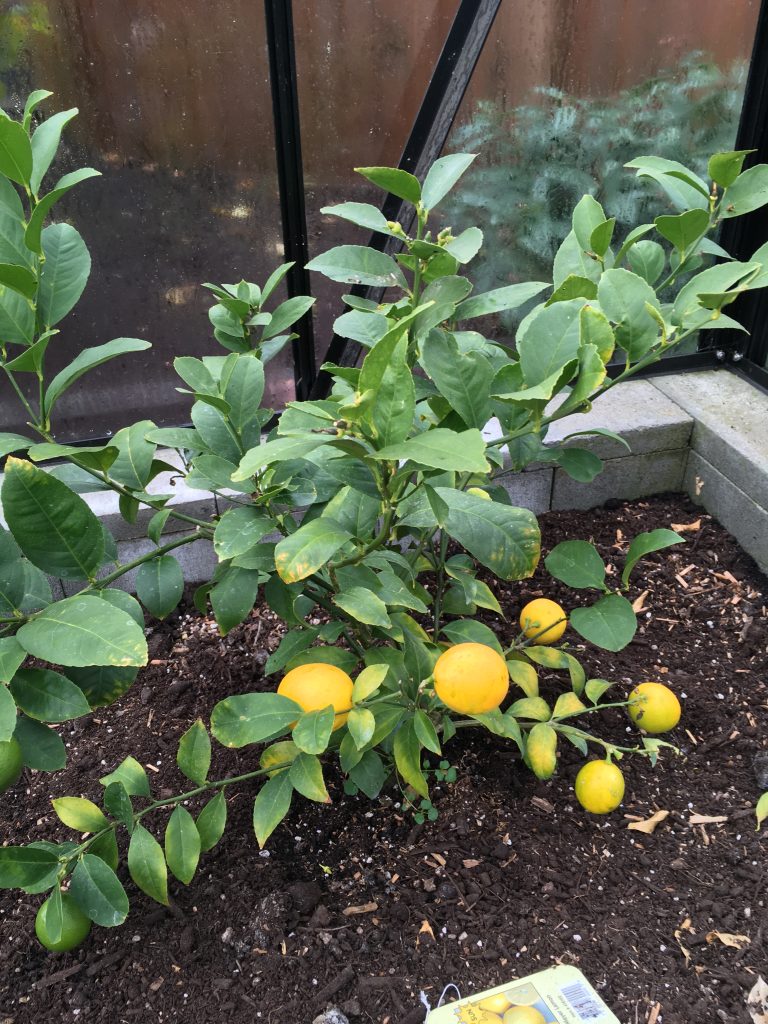 Planted this spring in his greenhouse, Cam harvested lemons to make a lemon pie and tarts. Yummy. What would you do with lemons if you decide to grow them?
Planted this spring in his greenhouse, Cam harvested lemons to make a lemon pie and tarts. Yummy. What would you do with lemons if you decide to grow them?
Let me know what you are cooking from your garden. Sometimes it’s not all about helping gardeners grow. It is about growing and cooking and enjoying every stage along the way.
What Would Donna Do?
Get my growing and gardening tips and pointers throughout the season.
3 Comments
Submit a Comment






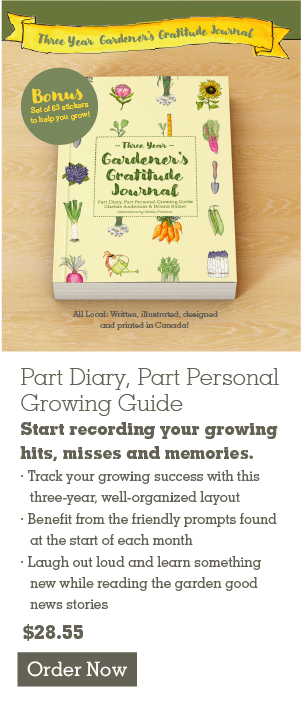





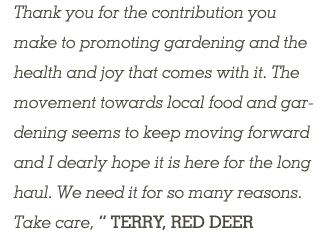

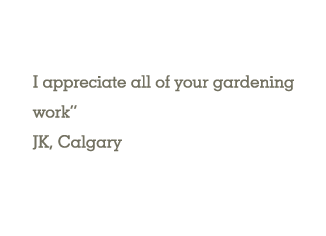

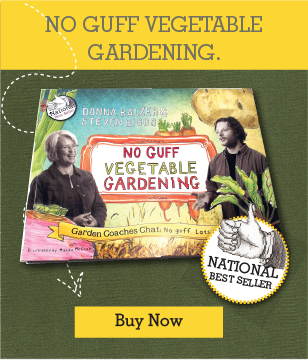
Nice. Thanks Amanda
Great Idea Amanda – it did seem like too much to waste. And PS I had so little celery this year I used the entire stems and ends all at once. Thanks for your comment
Donna, I always save the green parts of the leek for whenever I make stock. I put celery ends and leek tops in a bag in the freezer, then pull it out when I’m ready to make stock, adding in onions and carrots like you do, as well as bay leaf and peppercorns. I usually use the bones from a roast chicken also to make chicken stock.